Building a 21st Century Freemasonry Legacy: Fostering Open Science and a Culture of Peace
With roots in the Middle Ages, Freemasonry is a fraternal organization that values the pursuit of knowledge, equality, and fraternity.
This article explores how this Order has historically influenced the promotion of science and the culture of peace and how it may continue to do so.
Studying the relationship between Freemasonry, science, and peace is crucial to understanding how these interactions can contribute to a more fair, peaceful, and multipolar world in the contemporary context.
Over three centuries, our Freemasonic forefathers have promoted the pursuit of knowledge and the values of Brotherhood, tolerance, and philanthropy, positioning this, our august Institution to become an influential force in promoting open science and peace through the ethical adoption of emerging technologies (such as artificial intelligence, blockchain or the internet of things, to name a few).
We must use our tools to seek, study, and understand how these links can be strengthened in the 21st century to create a lasting legacy for our Order and for new generations.
To understand how Freemasonry has promoted science and peace, it is imperative to explore its roots in the Enlightenment, a time of significant intellectual and scientific advancement.

IMAGE: the square magazine digital collection
Freemasonry in the Enlightenment: Drivers of Progress and Modernity
Undoubtedly, the Order has been a pillar in the promotion of scientific thought and intellectual freedom.
By adopting and promoting the ideals of the Enlightenment and critical thinking, Freemasons of the past and present have contributed significantly to human progress and the emancipation of thought, reaffirming the relevance of science and reason in the construction of freer and more fair societies (Bauer, 2007).
The figure of Newton, a teacher and friend of some of the first Freemasons, and his influence on the Order are, of course, due to his role as a philosopher and mathematician.
His focus on the science of ideas and nature aligns with Masonic principles of exploring the physical and philosophical world.
In our work, we take up the traditions of the cathedral builders and great thinkers such as Pythagoras, highlighting the importance of science and intellect (Harrison, 1995).
Free and Accepted Masons have played a significant role in scientific progress and the emancipation of human thought throughout history.
As an organization, Freemasonry is dedicated to historical research and the validation of knowledge, promoting a culture of learning and critical reflection.
Masons have endeavored to recover lost texts and validate historical and scientific hypotheses, demonstrating their commitment to truth and reason.
According to Stevenson (1990), these activities reflect the Brotherhood’s dedication to pursuing knowledge and advancing human understanding. However, the extent and formalization of these activities may vary between lodges and eras.
Underlining the importance of learning and transmitting ideas to different degrees, our Order stands out for its continuous transmission of knowledge through generations. This process of integration and intellectual liberation is essential to our identity.
The principles of Freemasonry, such as the pursuit of knowledge, personal improvement, and service to humanity, are closely aligned with the objectives of public education, which is why the promotion of reason and free inquiry are essential aspects of Freemasonic philosophy that have influenced modern pedagogy.
In colonial America (meaning the entire continent), the majority of the population lived around the port cities, where many of the first Freemasonic lodges were located (Gorley, 2014). In that period, formal education was a luxury reserved mainly for the wealthy, children of merchants, military men, and the children of Europeans born in the Americas.
Freemasons had the advantage of being able to educate themselves in their lodges, where practical skills and civic values were learned, fostering Order and harmony in civil society (Gorley, 2014).
The ideals of the Enlightenment impacted scientific thought and profoundly influenced public education, a sphere in which Freemasonry left a significant mark.

IMAGE: the square magazine digital collection
Free Thinking: Foundation of Public Education
Anderson’s Constitutions, which promote freedom of conscience and expression within the lodge, reflect a liberal approach to thought and faith.
Thus, the Brotherhood advocates intellectual autonomy and the non-imposition of religious or political beliefs on its members, an approach based on the idea that Freemasons should obey the moral law and uphold their personal religious and political beliefs without imposing them on others and when they do not contradict the fundamental principles of ethics.
This emphasizes tolerance and acceptance of diversity of thought as a central pillar of Freemasonry (Anderson, 1723).
Furthermore, it is imperative to mention that the Order promoted the idea of intellectual freedom and personal autonomy long before these concepts became accepted social norms (Jacob, 1991).
This influence of Freemasonry in the evolution of liberal and democratic thought underlines its role in promoting freedom of opinion, which emphasizes the importance of tolerance and diversity of thought (Knoop & Jones, 1947).

IMAGE: the square magazine digital collection
Educational Transformation in the Global South
In Latin America, Freemasonry played a vital role in independence and establishing modern educational systems.
During the wars of independence, Freemason leaders such as Simón Bolívar or José de San Martín promoted education as a means for social progress and the consolidation of the new republics.
This relationship between education and Freemasonry is deeply rooted in the founding of Latin American republics and the political, economic, and cultural changes of the 19th century (Báez Osorio, 2004).
Similarly, in Europe, there is a connection between scientific thought and freedom of expression, driven by liberal, Protestant, and Masonic ideas, which promoted a vision of progress based on individual and national freedom and economic, technological, and scientific development.
In Mexico, the Reform Laws limited the power of the Church to favor a more liberal and secular environment, encouraging ideological openness.
Freemasons played an essential role in these reforms and in promoting democratic practices and the establishment of public education (Flores Suárez, 2015; Secretaría de Cultura, 2016).
A notable example of the significant role of the Order in the promotion of secular and free public education is, without a doubt, the educational reform in Uruguay.
There, the Brotherhood played a central role in the modernization of the educational system, guaranteeing freedom of conscience and providing an education that kept up with the times and was accessible to all citizens (Fernandez Cabrelli, 1990).
To this end, the Order advocated the elimination of religious instruction in public schools, proposing instead an adogmatic education that could serve a diverse population in terms of beliefs and values.
This educational approach focused on inclusion and accessibility, ensuring that all children, regardless of socioeconomic background, had access to quality education.
In 1857, the Philanthropic Society, linked to Uruguayan Freemasonry, founded the first secular school in Montevideo, followed by other institutions in the interior of the country, thus establishing a model that expanded rapidly (Fernández Cabrelli, 1990).
In Africa, there was also an influence on educational development. In Ghana, the first lodge was founded in the early 19th century, where the promotion of education and technical training contributed to the development of an educated middle class that played critical roles in the struggle for independence and post-colonial development (O’Sullivan, 2008).
This practice spread to other British colonies, such as Nigeria and South Africa.
The Order’s influence in Asia is seen mainly in India and the Philippines, where lodges promoted education and liberal thought. In the Philippines, the Order played an important role in the struggle for independence from Spanish rule, with figures such as José Rizal (a revolutionary leader and Freemason) who advocated for public education and freedom of thought (Quezada, 2020).
We can follow the legacy and work of Freemasons for education to the present day with efforts ranging from scholarships, research centers, and the promotion of reforms that deepen the right and access to education, such as the important role of the Grand Lodge of Argentina that promotes and promotes the “Environmental Education Law: Law 1420 of the XXI Century”, a project of the environmental education law, combining a fundamental pillar, such as education and the environment, encouraging schools to generate a multidisciplinary and plural space (Maestre, 2020).
In understanding the relationship between Freemasonry and education, it is crucial to analyze how this relationship has extended into the realm of science, establishing a deep historical and philosophical connection.

IMAGE: the square magazine digital collection
Freemasonry and Science: A Historical and Philosophical Relationship
The relationship between the Order and scientific development began with the role of Freemasons in the Royal Society in England. In this sense, Renaissance humanism was a determinant for developing modern science and Freemasonry (Galily, 2016).
Numerous prominent figures in science and technology have been Freemasons, and the Order has fostered a favorable environment for scientific innovation.
In 18th-century England, the Brotherhood, influenced by Newtonianism, played a key role in science education during the Enlightenment. Scientific lectures were given in some lodges at that time, illustrating the importance of natural philosophy in Freemasonic rhetoric (Elliott & Daniels, 2006).
The literature shows that the Royal Society not only shared members with Freemasonry but also a common philosophy of the pursuit of knowledge and scientific progress, highlighting how the Freemasons were fundamental in the consolidation of this prestigious scientific organization (Lomas, 2002; Schuchard, 2002).
This influence contributed to a scientific mentality open to new ideas and experimental methods, essential for the development of modern science.
During the Industrial Revolution in the United Kingdom, counties with a high number of Freemasons experienced more innovation in terms of new patents and exhibitions at the 1851 Crystal Palace World’s Fair.
This suggests a relationship between Freemasonry and scientific innovation in this period (Galofré-Vilà, 2023).
Durante la Revolución Industrial en el Reino Unido, los condados con un alto número de francmasones experimentaron más innovación en términos de nuevas patentes y exhibiciones en la Feria Mundial de Crystal Palace de 1851.
Esto sugiere una relación entre la francmasonería y la innovación científica en este período (Galofré-Vilà, 2023).
In Hungary during the 18th century, the Order promoted social culture and scientific innovation by establishing learned societies guided by principles such as the dissemination of Enlightenment and support for the sciences and the arts (Lengyel & Tüskés, 2017).
In the 19th century, the Industrial Revolution and scientific advances were interrelated phenomena that greatly impacted Freemasonry.
Many prominent Freemasons were also prominent scientists and engineers, and membership in the Brotherhood provided a network of contacts and an environment conducive to discussion and exchanging ideas.
A prominent example is Michael Faraday, a Fellow of the Royal Society and Freemason, known for his discoveries in electromagnetism and electrochemistry (Thomas, 1991).
His work advanced science and had practical implications that transformed industries.
In late Ottoman Lebanon, Freemasons played a role as agents of the first wave of globalization in the 19th and 20th centuries (Sommer, 2015).
Throughout the 20th century, Freemasonry was part of the trend that drove various intellectual currents, including scientific innovations such as Darwinism and Einstein’s theory of relativity (Bacsó, 2014).
During the 20th century, the relationship between Freemasonry and science became more complex, integrating into a global network of innovation and technological change.
Lodges continued to promote scientific knowledge and multidisciplinary research. The Scientific-Technical Revolution of the 20th century transformed the global village with innovations ranging from computing to biotechnology.
The integration of scientific discoveries into consumer products and industrial technologies was driven by large corporations and research laboratories, instrumental in developing and commercializing inventions such as the transistor and modern communication systems (Teich, 1996; Gertner, 2022).
The analysis of contemporary Masonic studies has led to a better understanding of how personal and professional connections within Freemasonry have facilitated the diffusion of scientific and technical ideas.
This interdisciplinary approach has enriched the understanding of the Order’s influence on forming social and cultural norms throughout the twentieth century (Beaurepaire, 2010).
The relationship between Freemasonry and science in the 19th and 20th centuries is a topic of considerable historical interest.
The Order has been a focal point for many scientists, engineers, and thinkers who have contributed significantly to developing knowledge and technology through intellectual exchange (Bird & Sherwin, 2005).
As we shall see, influence is found in science and in promoting a culture of peace.

IMAGE: the square magazine digital collection
Promoting a Culture of Peace through Freemasonry
As an organization, Freemasonry promotes universal values essential to building a culture of peace, such as respect for human dignity, social justice, and solidarity. Fostering dialogue and mutual understanding among lodge members from diverse cultures and religions was and is fundamental.
A study by Albert Pike (1871) highlights that Freemasonic principles are aligned with the promotion of peace and social harmony.
However, it is important to recognize the contradiction present in the figure of Pike, who was a slaveholder.
This paradox highlights the complexities and tensions within Freemasonry in different historical eras. According to Pike, it seeks the moral and intellectual improvement of members, thus contributing to the formation of citizens committed to peace and the common welfare (Pike, 1871).
The influence of the Brotherhood in peace movements and its role in conflict resolution has been continuous and active. Masons have participated in peace-building initiatives, promoting reconciliation and intercultural understanding (Ferrer Benimeli & Paz Sanchez, 2001).
Freemasonry has significantly impacted not only promoting peace and fraternity but also the political and diplomatic spheres throughout history. Various studies have examined how Freemasons have influenced important political and social movements in different historical and geographical contexts.
Let’s review some historical examples of Freemasons as agents of change to illustrate better Freemasonry’s impact on promoting peace.

IMAGE: the square magazine digital collection
Historical Examples of Freemasonic Impact on Peace
Historically, several prominent Freemasons have been advocates of peace. A prime example is U.S. President Franklin D. Roosevelt, who played an important role in the formation of the United Nations, dedicated to the promotion of global peace and security.
Another example: the contribution of Freemasonry in the French Revolution, in which the principles of liberty, equality and fraternity influenced the declaration of the rights of man and citizen, a document promoting peace and equality (Ferrer Benimeli & Paz Sánchez, 2001; González, 2017).
During the last phase of the Ottoman Empire, the Order played a significant role in politics and diplomacy through the Committee of Union and Progress (CUP).
This relationship was complex and multifaceted, as Freemasonry provided a safe space for the exchange of reformist and modernizing ideas (Tiryaki, 2022). CUP Freemasons used their network to further common goals of modernization and democratization of the empire (Hanioglü, 1989).
In Eastern Europe, the influence of Freemasonry in Kamianets-Podilskyi (Ukraine) spans mainly the 19th and early 20th centuries, i.e. during the period when the region was part of the Russian Empire and, briefly, of the independent Ukraine after World War I.
In Kamianets-Podilskyi, the Brotherhood shaped the ideas and symbols of the region. In Kamianets-Podilskyi, the Brotherhood shaped the ideas and symbols of the region.
The Masons demonstrated a remarkable ability to integrate universal concepts of liberty and fraternity with local cultures, thus promoting peace and social cohesion.
In this region it not only fostered education and enlightenment, but also played a role in the formation of national identities and resistance against external oppressions.
Mykhailo Hrushevsky, historian, scholar and Freemason, was one of the most influential figures during this era (Zadorozhnyuk, 2022).
The influence on peace building and diplomacy is also evident in the case of King Oscar II of Sweden who maintained close connections with Romanian Freemasonry.
These relations facilitated diplomatic and cultural exchanges between Sweden and Romania, contributing to stability and cooperation in the region.
The influence of Freemasonry in these contexts demonstrates its ability to serve as a bridge between different cultures and political systems, promoting peace and diplomacy (Varga, 2024).
These historical examples lead us to consider how the Order can continue to influence the modern world, especially at the intersection of open science and emerging technology.

IMAGE: the square magazine digital collection
Open Science and Technology: Pathways to Peace and Sustainability
Now that we have briefly reviewed the Order’s relationship with education, science, and the culture of peace, it is time to address the present and future prospects.
To understand open science, we must first understand its definition and inclusive approach, which makes scientific knowledge accessible and usable to all.
This concept—open science—promotes transparency, accessibility, and collaboration in the scientific process, allowing researchers, citizens, and various institutions to share and reuse scientific data.
According to UNESCO (2021), open science is essential to accelerating the achievement of the Sustainable Development Goals, as it facilitates innovation and reduces knowledge gaps between countries and regions.
Open Science combines free access to data, methods, and research results with the values of universalism and science to democratize scientific endeavors and re-institutionalize science as a public activity today (Mielkov, 2022).
The principles of open science include open access, open data, open software, and reproducibility (Abadal & Anglada, 2020), which have been expanded to eight elements according to the recommendations of the “Open Science Policy Platform” OSPP created by the European Union.
The International Science Council (2020) defines open science as:
“Science that is open to scrutiny and challenge, and to the needs and interests of the broadest audiences.
Open Science makes the record of science, its evolving stock of knowledge, ideas and possibilities accessible and free to all, regardless of geography, gender, ethnicity or financial circumstances.”
That is, to see science as a public good. Understanding open science and its relationship to Freemasonry is fundamental to appreciating its importance to sustainable development and progress in the 21st century.

IMAGE: the square magazine digital collection
The Role of Open Science in Sustainable Development
Open science is essential for sustainable development and progress in the 21st century for several reasons:
● Equal Access to Knowledge: It provides equitable access to scientific knowledge, allowing all people, regardless of their geographic or socioeconomic location, to benefit from scientific advances (Peters, 2014).
● Promotion of Innovation: By sharing data and findings openly, collaboration and innovation are promoted. Researchers can build on the work of others, accelerating the discovery and application of solutions to global problems (Leonelli, 2023).
● Transparency and Accountability: Openness in science increases transparency and accountability, which can strengthen public trust in science and scientific institutions (Funamori, 2017).
● Reduction of the Digital Divide: By providing access to scientific resources globally, open science helps to reduce digital and knowledge divides between different countries and regions, especially between developed and developing countries (Ahmat, 2018).
To further explore how open science can facilitate sustainable development, we will explore the role of new technologies in this context.

IMAGE: the square magazine digital collection
Integrating Emerging Technologies for a Sustainable Future
Adopting new technologies is an essential component of open science, facilitating access to and dissemination of knowledge.
For example, using technologies such as the radio frequency identification system and digital technologies in university projects improves the educational environment and digital competencies, thus promoting a culture of peace by creating comfortable environments and enriching educational experiences.
Initiatives such as Harvard University’s “University Libraries in the Digital Era” project (Courtney & Kilcer, 2016), Kemerovo State Institute of Culture’s “Library of a New Generation in the Creative University” project (Bobrova, 2022) and Zenodo, an open access research repository platform developed by CERN that allows researchers from all disciplines to share, preserve and display their research data (CERN, 2013), are prominent examples of how these technologies can be effectively implemented.
Emerging technologies such as blockchain can also be powerful tools in open science, promoting sustainable resource management and sharing culture.
One study demonstrated how blockchain technology and sharing culture can improve sustainable forest management in tribal communities, promoting traditional spiritual culture and community management (Peng & Huang, 2022).
In addition, artificial intelligence (AI) plays an important role in open science by enabling massive data analysis and automation of complex processes.
AI can facilitate access to information and improve efficiency in scientific research. According to an OECD report (2021), AI has the potential to accelerate scientific productivity, supporting countries’ ability to grow, innovate, and address global challenges, from climate change to new communicable diseases (OECD, 2021).
These are some examples of how the ethnosphere can be preserved with emerging technologies. In addition to their impact on sustainability, open science, and new technologies also have a significant role to play in promoting a global culture of peace.

IMAGE: the square magazine digital collection
Open Science: Pillar for a Global Culture of Peace
Open science also contributes significantly to the culture of peace by promoting collaboration and global understanding.
According to UNESCO (2021), open science can be a valuable tool for intercultural dialogue and international cooperation, essential for addressing global challenges such as climate change, public health, and food security.
The philosophy of openness in education and science, which emphasizes transparency and unrestricted access to knowledge, fosters a culture of peace through collaborative decision-making and creating an inclusive educational environment (Bossu & Heck, 2020).
Universities and other higher education institutions can contribute significantly to global peace through academic diplomacy, using science and knowledge to improve a country’s international standing and promote a culture of peace (Zakerian et al., 2017).
Furthermore, the implementation of the Sustainable Development Goals (SDGs) in modern education, which includes promoting peace and nonviolence through global citizenship education and recognition of cultural diversity, further underscores the importance of open science in promoting peace (Zinchenko, 2022).
Bringing these elements together, we can conclude by reflecting on how Freemasonry, open science, and technology can collaborate to create a lasting legacy of peace and knowledge.

IMAGE: the square magazine digital collection
Discussion: The Future Legacy of Freemasonry
Since the Enlightenment, Freemasons have been advocates of critical thinking, reason and equality. In the contemporary context, Freemasonry has an opportunity to align its historical principles with the goals of open science and sustainable development.
Freemasonry’s commitment to education and the dissemination of knowledge can be a powerful catalyst for adopting new and emerging technologies ethically.
These technologies, combined with the principles of open science, can facilitate equitable access to knowledge and foster a culture of peace.
Adopting new technologies, such as artificial intelligence and blockchain, within the open science framework offers unique opportunities to promote sustainability and global peace.
However, implementing these technologies must be guided by sound ethical principles aligned with the Masonic values of equality, fraternity, and the pursuit of knowledge.
In addition, Freemasonry has played a crucial role in promoting inclusive education and the elimination of socio-economic barriers, thus contributing to the development of more just and equitable societies.
The preservation of the ethnosphere, which encompasses cultural diversity and traditional knowledge, is an objective that the Order can actively support by promoting open science.
The relationship between Freemasonry and open science is particularly relevant in the current context, where scientific accessibility and collaboration are essential to address global challenges such as climate change, public health, and social justice.
Freemasonry can play a vital role in promoting a culture of peace by collaborating with diverse communities and facilitating intercultural dialogue.
By fostering transparency, accessibility and global collaboration in science, the Brotherhood can help address contemporary global challenges and contribute to sustainable development.
Historical examples of influential Masons in educational and political movements highlight the Order’s ability to adapt and respond to the changing needs of society.
Freemasonry, with its rich tradition of promoting science and peace, is uniquely positioned to lead in the 21st century in embracing open science and emerging technologies.
Integrating these elements into Masonic principles can strengthen the Order’s commitment to sustainability and social justice, creating a lasting legacy for future generations.
The interaction between Freemasonry, open science and peace is essential to address today’s global challenges.
This collaboration will not only drive sustainable development and innovation, but will also contribute significantly to preserving the ethnosphere and fostering a global culture of peace.
In short, open science and the adoption of new technologies are fundamental to promoting a culture of peace and sustainable development in the 21st century.
Freemasonry, with its emphasis on knowledge, equality and peace, can be a powerful ally in promoting open science. Through the promotion of education and the adoption of open science practices, Freemasonry can help create a more equitable, sustainable and peaceful world.
It is imperative that members of Freemasonry and the community at large actively engage in open science and the ethical adoption of emerging technologies. This commitment should include:
1. Promotion of Open Science and Education: Support educational initiatives promoting open knowledge access and global scientific collaboration.
2. Adoption of Emerging Technologies: Adopt artificial intelligence and blockchain technologies to promote sustainability and ethical resource management.
3. Promotion of the Culture of Peace: Participate in programs and projects promoting intercultural dialogue and international cooperation.
Freemasons, Scholars, and peace advocates are invited to collaborate and foster these relationships to create a more peaceful and equitable world.
By following these principles, Freemasonry can continue to be a powerful force for good in the world, promoting a future of peace, knowledge, and justice for all.
Footnote
References
1. Abadal, E., & Anglada, L. (2020). Ciencia abierta. Anales de Documentación, 23(1), 1-10. https://dx.doi.org/10.6018/analesdoc.378171
2. Agre, P., & Turekian, V. (2010). Advancing Science, Promoting Peace. Science Translational Medicine. https://dx.doi.org/10.1126/scitranslmed.3001223
3. Ahmat, M. A. (2018). Mengukur Tahap Kesediaan Open Science (Sains Terbuka) Di Institusi Pengajian Tinggi Awam Malaysia. https://www.researchgate.net/publication/337889786_MENGUKUR_TAHAP_KESEDIAAN_OPEN_SCIENCE_SAINS_TERBUKA_DI_INSTITUSI_PENGAJIAN_TINGGI_AWAM_MALAYSIA
4. Anderson, J. (1723). The Constitutions of the Free-Masons. William Hunter. Recuperado de https://archive.org/details/constitutionsoff00andeuoft/page/8/mode/2up
5. Bacsó, B. (2014). Karinthy Frigyes, újgnosztikus áramlatok: spiritizmus; teozófia; antropozófia. Krúdy Könyvtár. http://www.krudy.hu/Szakirod/OnderCsaba/OndCsIrM14_3.pdf
6. Báez Osorio, M. (2004). La Masonería y su influencia en la escuela laica colombiana. Revista Historia De La Educación Colombiana, 6(6 y 7), 67-80. Recuperado de https://revistas.udenar.edu.co/index.php/rhec/article/view/1124
7. Bauer, A. (2007). Isaac Newton’s Freemasonry: The alchemy of science and mysticism. Inner Traditions.
8. Bauer, D. (2005). The Enlightenment and the Intellectual Foundations of Modern Culture. Yale University Press.
9. Beaurepaire, P.-Y. (2010). Researching Freemasonry in the twenty-first century: Opportunities and challenges. Journal for Research into Freemasonry and Fraternalism, 1(2), 247-255. https://doi.org/10.1558/jrff.v1i2.247
10. Bird, K., & Sherwin, M. J. (2005). American Prometheus: The triumph and tragedy of J. Robert Oppenheimer. Vintage Books.
11. Bobrova, E. (2022). Software and Hardware Support of the Project “Library of a New Generation in Creative University” at the Kemerovo State Institute of Culture. Bibliosphere. https://dx.doi.org/10.20913/1815-3186-2022-3-49-56
12. Bossu, C., & Heck, T. (2020). Special Issue: Engaging with Open Science in Learning and Teaching. Education for Information. https://dx.doi.org/10.3233/EFI-200386
13. Courtney, K., & Kilcer, E. (2016). University libraries in the digital era. En F. Xavier Olleros & M. Zhegu (Eds.), Research Handbook on Digital Transformations (pp. 135-159). Edward Elgar Publishing. https://dash.harvard.edu/handle/1/38482466
14. CERN. (2013). Zenodo. Zenodo. https://about.zenodo.org/
15. Elliott, P., & Daniels, S. (2006). The ‘school of true, useful and universal science’? Freemasonry, natural philosophy and scientific culture in eighteenth-century England. The British Journal for the History of Science, 39(2), 207-229. https://dx.doi.org/10.1017/S0007087406007965
16. Fernández Cabrelli, A. (1990). Iglesia y masonería en la reforma de la escuela uruguaya. Ediciones Universidad de Salamanca. Historia de la Educación, 9, 1-16. http://hdl.handle.net/10366/79509
17. Ferrer Benimeli, J. A., & Paz Sánchez, M. A. de. (2001). Masonería y pacifismo en la España contemporánea. Prensas de la Universidad de Zaragoza.
18. Flores Suárez, E. (2015). Protestas liberales y francmasones. Revista Mexicana De Ciencias Políticas Y Sociales, 36(146). https://doi.org/10.22201/fcpys.2448492xe.1991.146.51596
19. Funamori, M. (2017). Open Science and the Academy: A Theoretical Discussion. En Proceedings of the 2017 IIAI International Conference on Advanced Applied Informatics (pp. 1-6). IEEE. https://dx.doi.org/10.1109/IIAI-AAI.2017.19
20. Galily, D. (2016). The Humanism of the Renaissance as the Source of the Freemason Order. Imperial Journal of Interdisciplinary Research (IJIR), 2(8).
21. Galofré-Vilà, G. (2023). The Diffusion of Knowledge during the British Industrial Revolution. Social Science History, 47(1), 159-188. https://dx.doi.org/10.1017/ssh.2022.49
22. Gertner, J. (2022). What made the last century’s great innovations possible? Science News. https://www.sciencenews.org/article/century-scientific-innovation-invention-technology
23. González, C. E. R. (2017). Construcción de Paz desde la publicación científica. Revista Latinoamericana de Ciencias Sociales. https://dx.doi.org/10.22335/rlct.v9i2.579
24. Gorley, S. M. (2014). Masons and Public Education. The Laudable Pursuit. Recuperado de https://www.thelaudablepursuit.com/articles/2015/2/2/masons-and-public-education
25. Hanioglü, M. Ş. (1989). Notes on the Young Turks and the Freemasons, 1875-1908. Middle Eastern Studies, 25(2), 186–197. http://www.jstor.org/stable/4283298
26. Harrison, P. (1995). Newtonian Science, Miracles, and the Laws of Nature. Journal of the History of Ideas, 56(4), 531-553. https://doi.org/10.2307/2709991
27. Herrick, J. A. (2009). The History and Philosophy of Freemasonry. Routledge.
28. Jacob, M. C. (1991). Living the Enlightenment: Freemasonry and Politics in Eighteenth-Century Europe. Oxford University Press.
29. Jacob, M. C. (1991). The Cultural Meaning of the Scientific Revolution. Knopf.
30. Kerber, G. (2012). Asumiendo el pasado. Construyendo el presente: dilemas éticos. Revista Cultura. https://dx.doi.org/10.5377/CULTURA.V18I57.797
31. Knoop, D., & Jones, G. P. (1947). The Genesis of Freemasonry: An Account of the Rise and Development of Freemasonry in Its Operative, Accepted, and Early Speculative Phases. Manchester University Press. https://verity59.org/uploads/3/4/7/7/34770163/1974-genesis_of_freemasonry_-_knoop___jones.pdf
32. Lengyel, R., & Tüskés, G. (Eds.). (2017). Learned societies, freemasonry, sciences and literature in 18th-century Hungary: A collection of documents and sources. Hungarian Academy of Sciences. https://real.mtak.hu/70929/1/Learned%20Societies_K%C3%96NYV.pdf
33. Leonelli, S. (2023). Philosophy of Open Science. Cambridge University Press. https://dx.doi.org/10.1017/9781009416368
34. Lomas, R. (2002). The Invisible College: The Royal Society, Freemasonry and the Birth of Modern Science.
35. Maestre, G. (2020). La Masonería Argentina impulsa una Ley de Educación Ambiental Ley 1420 del Siglo XXI – Gran Logia de la Argentina. Masoneria-Argentina.org.ar. https://www.masoneria-argentina.org.ar/la-masoneria-argentina-impulsa-una-ley-de-educacion-ambiental-ley-1420-del-siglo-xxi/
36. Mensching, G. (2021). Roger Bacons Idee der Einheit der Wissenschaft und des universalen Friedens. Historical Studies in the Natural Sciences. https://dx.doi.org/10.4324/9781003033943-7
37. Mielkov, Y. (2022). The notion of ‘Open Science’: its values and meaning for the higher education system. Philosophy and Education, 27(2), 1-13. https://dx.doi.org/10.31874/2309-1606-2021-27-2-1
38. Moreau, J. (2014). Freimaurer: Der Mythos eines einflussreichen Netzwerkes. Bundeszentrale für politische Bildung. Recuperado de https://www.bpb.de/themen/europa/frankreich/177783/freimaurer-der-mythos-eines-einflussreichen-netzwerkes/
39. OECD. (2021). Artificial Intelligence in Science: Challenges, Opportunities and the Future of Research. https://www.oecd-ilibrary.org/docserver/a8d820bd-en.pdf?expires=1717166233&id=id&accname=guest&checksum=40212EE5CBBF1A529EB80912B58B391B
40. O’Sullivan, M. (2008). The implications of political, socio-economic and ideological factors for teaching and learning in Namibia: An historical review. Irish Educational Studies, 23(1), 1-14. https://doi.org/10.1080/0332331040230104
41. Peng, Y., & Huang, W. (2022). Using Blockchain Technology and Sharing Culture to Promote Sustainable Forest Management in Tribal Communities. Journal of Environmental and Public Health. https://dx.doi.org/10.1155/2022/1529407
42. Peters, M. (2014). Open Science, Philosophy and Peer Review. Educational Philosophy and Theory, 46(11), 1230-1241. https://dx.doi.org/10.1080/00131857.2013.781296
43. Pike, A. (1871). Morals and Dogma of the Ancient and Accepted Scottish Rite of Freemasonry. Charleston: Supreme Council, 33°, Southern Jurisdiction, U.S.A. https://archive.org/details/moralsdogmaofanc0000unse/page/n1/mode/2up
44. Quezada, R. (2020). Supranational influence of UNESCO in Latin American higher education. Revista Española de Educación Comparada, 37, 89-106. https://doi.org/10.5944/reec.37.2021.27884
45. Schméder, G. (2001). A reconsideration of the idealistic vision of science for peace. Technology in Society. https://dx.doi.org/10.1016/S0160-791X(01)00024-0
46. Schuchard, M. K. (2002). Chapter Ten: “The Pleasant Theatre of Naturall Things”: Rosicrucianism, Freemasonry, and the Royal Society (1660-1673). En Restoring the Temple of Vision. Brill. https://doi.org/10.1163/9789004247611_012
47. Secretaría de Cultura. (2016). Influencia de la masonería en la Constitución de 1917. Instituto Nacional de Estudios Históricos de las Revoluciones de México. https://www.inehrm.gob.mx/work/models/inehrm/Resource/455/1/images/Consititucion_1917_y_Masoneria.pdf
48. Serrão, D. (2009). A Utopia da Paz Universal. Revista Saber Educar. https://dx.doi.org/10.17346/SE.VOL14.117
49. Sommer, D. (2015). Freemasonry in the Ottoman Empire: A history of the fraternity and its influence in Syria and the Levant. I.B. Tauris.
50. Stevenson, D. (1988). The Origins of Freemasonry: Scotland’s Century, 1590-1710. Cambridge University Press.
51. Teich, M. (1996). The 20th-century scientific-technical revolution. History Today, 46(11). Recuperado de https://www.historytoday.com/archive/20th-century-scientific-technical-revolution
52. Thomas, J. M. (1991). Michael Faraday and The Royal Institution: The Genius of Man and Place. CRC Press.
53. Tiryaki, R. M. (2022). Freemasonry’s political and diplomatic entanglements in the last phase of Ottoman history: the peculiar case of the Committee of Union and Progress. Middle Eastern Studies. https://dx.doi.org/10.1080/00263206.2022.2109147
54. UNESCO. (2021). UNESCO Recommendation on Open Science. https://unesdoc.unesco.org/ark:/48223/pf0000379949
55. Varga, A. C. (2024). King Oscar II of Sweden and his connections with the Romanian freemasonry. Scandinavian Journal of History. https://dx.doi.org/10.35824/sjrs.v7i2.25931
56. Wolfe, A. (2019). Freedom’s Laboratory: The Cold War Struggle for the Soul of Science. https://dx.doi.org/10.2478/HOST-2019-0018
57. Zadorozhnyuk, A. (2022). Freemasonry in Kamianets-Podilskyi: ideas, people, symbols. History of European Ideas. https://dx.doi.org/10.32626/2309-2254.2022-37.157-168
58. Zakerian, M., Sadoughi, Z., Nabavi, A., & Mahdi, R. (2017). Realization of Peace from the Perspective of the Role of Higher Education in the Field of Diplomacy: Experience of Academic Diplomacy in Iran. Journal of Fundamental and Applied Sciences. https://dx.doi.org/10.4314/JFAS.V9I1S.686
59. Zinchenko, V. (2022). Implementation of Sustainable Development Goals in the New Institutional Reality for Education. Pedagogical Sciences and Education. https://dx.doi.org/10.32744/pse.2022.4.1
Article by: Martin Ignacio Díaz Velásquez

Martin Diaz was initiated in 2012 in the Prometeo Lodge N° 367 in Buenos Aires, Argentina (GLA). He actively promotes open science, protection of the ethnosphere, and human dignity within Freemasonry.
As a Protestant bishop, Martin is committed to social research, human dignity, and the ethical adoption of emerging technologies.
He is currently the Executive Director of the Knowmad Institut in Germany, where he leads initiatives in human rights, emerging technologies, and sustainable development.
He also serves in the secretariat of the Rome Consensus 2.0 and is a One Young World ambassador. Martin is the author of numerous publications on humanitarian public policy and human rights.
Articles by Others: VR/AR/AI metaverse freemasonry
 The Great Algorithm of the Universe Explore the algorithmic essence of the Universe, from complex to simple and back again. Dive into the stochasticity of nature, the organic and inorganic omniverse, and the unexpected excellence of algorithmic data. Discover how repetitive processes yield extraordinary exceptions, much like the historic publication of the freemason’s constitutions. |
 Building a 21st Century Freemasonry Legacy: Freemasonry, rooted in the Middle Ages, values knowledge, equality, and fraternity. This article examines its historical influence on science and peace and its potential to continue this role. Understanding Freemasonry's relationship with science and peace is crucial for contributing to a fair, peaceful, and multipolar contemporary world. |
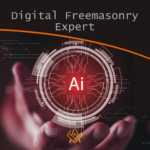 In the ever-evolving world of technology, artificial intelligence (AI) has revolutionized various industries, and now it's making its mark on Freemasonry. The Official Digital Freemasonry Community (ODFC) has introduced the "Digital Freemasonry Expert" AI tool, which aims to provide Masonic members with quick and accurate access to information, historical facts, and answers to their burning questions. This groundbreaking tool not only enhances the Masonic experience but also encourages dialogue and a deeper understanding of Masonic heritage. Join ODFC in embracing the digital transformation of Freemasonry and paving the way for innovation. |
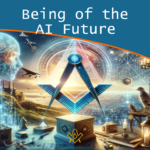 Being of the AI Future: Reflecting on the Knowledge of the Self Being of the AI Future; critically examines the shift from traditional power dynamics to data control in the AI era. It challenges us to rethink evolution and self-identity amidst AI's rise, highlighting Freemasonry's role and the need to balance technological progress with preserving human values. |
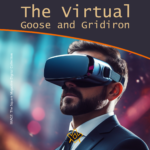 The Virtual Goose and Gridiron In a digital era where virtual reality blurs the lines between the tangible and the intangible, Masonry explores the metaverse. Here, a Masonic Hall stands grand in the virtual expanse, its public symbols beckoning seekers and brethren alike. Within, curated materials and private chambers offer knowledge and connection, transcending physical limits. |
 Freemasonry and Generative AI – Part 2 Freemasonry meets Generative AI: Dive into the profound intersection of ancient Masonic principles and cutting-edge artificial intelligence. Explore the ethical conundrums, ontological debates, and the evolving role of AI in Masonic traditions. Will Brother AI soon join the Masonic ranks? A must-read for tech enthusiasts and Freemasons alike. |
 The article explores using Virtual Reality (VR) for Masonic rituals, offering immersive experiences beyond traditional methods. While VR ensures consistent quality and flexibility, it might reduce group interactions. The author suggests Masonic bodies consider VR for specific rituals, highlighting its future potential. |
 Venturing into the Virtual Lodge: A Revolutionary Approach to Freemasonry Unlock the celestial secrets of Freemasonry! Discover how Masonic rituals transcend physical boundaries, reaching for the stars in a VR space. Join us on a cosmic journey, where ancient traditions meet cutting-edge technology under the watchful eye of the comet above. The future of Freemasonry is here! |
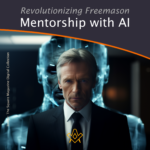 Revolutionizing Freemason Mentorship with AI Explore the intricate relationship between Freemasonry and mentorship in this captivating article. Unearth the rich history of this secretive fraternity, the symbol-laden rituals, and the transformative power of mentorship within the brotherhood. Delve into challenges faced and the potential impact of AI on Freemasonry mentorship. Immerse yourself in this intriguing journey! |
 The Future Use of Virtual Reality for Freemasonry Ritual Experience Freemasonry like never before! Dive into our ground-breaking research on harnessing Virtual Reality (VR) for Freemasonry rituals. We're transforming centuries-old traditions into immersive, accessible experiences. Discover how we're bridging the gap between historical symbolism and cutting-edge technology. Join us on this exciting journey into the future of Freemasonry! |
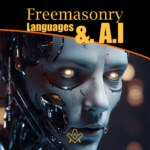 Unlock the enigmatic world of Freemasonry as we delve into its secret language. Explore the fascinating intersection of Generative AI and the Turin Test, unravelling the hidden codes and symbols that have intrigued generations. Discover the mysteries behind this ancient craft in our captivating introductory article. |
 Discover the exciting intersection of Freemasonry and AI. Explore how programming personal AI robots with Masonic principles like brotherly love, relief, and truth can revolutionize our interaction with technology, fostering a more ethical and empathetic AI future. Dive into the world of the Freemason AI robots now! |
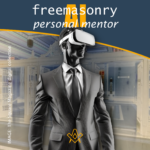 Imagine you are an AI-based personal development coach. Describe a subscription service that leverages cutting-edge technology and behavioural science to help users achieve their personal growth goals. What features would it have, and how would it keep subscribers engaged month after month? |
 Artificial Intelligence and its uses: from Society to Freemasonry Just as AI is not a panacea or a disaster, and the result depends on its use, so its application in Masonry will be beneficial and not counterproductive if the Brothers apply it constructively. By George Thanasoulas |
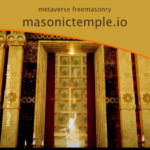 Metaverse freemasonry takes one step closer to become a reality as the Portuguese based company, Skyunicron, show case their Solomon Temple in the metaverse platform, a place for all Freemasons to meet in brotherly love and harmony, which at all times characterises freemasonry. Lets take a short tour….. |
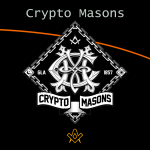 One of the first initiative for Masonic Art NFT collections with philanthropic goals supported by a regular Grand Lodge, in this case, the Great Lodge of Argentina of Free and Accepted Masons. |
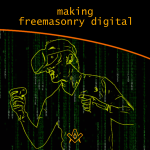 How do we prepare to make Freemasonry digital? Once we strip away the Masonic packaging, we are left with pure Freemasonry, which is not physical but content. |
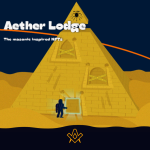 The vision is to satirize the many existing myths and preconceptions about Freemasonry by building a united community around an engaging story with multiple benefits. Aether Lodge consists of 9990 Masonic-themed NFTs divided into multiple collections. |
 What connects Freemasonry and Bitcoin ? Both are misunderstood and ridiculed by the ill-informed. If freemasonry is about being a better citizen of the world. Then Bitcoin is about: making the world a better place for all citizens |
 Metaverses, Masonry and Minecraft: The Future of Lodges Should Freemasons be proud that a clandestine group has borrowed their symbolism and ideology and transplanted it into a server known as ‘The Worst Place in Minecraft’? Metaverses, Masonry and Minecraft: The Future of Lodges |
 Freemasonry and the Metaverse P2 In this second instalment, Freemasonry and the Metaverse. We discusses the importance of being an open source protocol and how could Freemasonry benefit from a metaverse structure? |
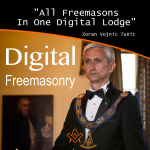 All Freemasons In One Digital Lodge; Is this viable?, is it practical ?, is it even possible ? To answer this question we need to under the problem "Digital Freemasonry" aims to fix. |
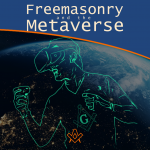 Freemasonry and the Metaverse P1 There is growing interest in the Freemasonry and the Metaverse on social media. Some projects are starting out as Masonic art NFT collections, while others are more clearly see a point in the future where they will be lodges operating in a metaverse. |
 Great Architect of the Metaverse Are you ready to meet in the metaverse ? what can you expect to see and do ? |
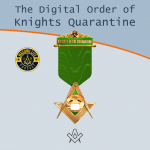 The Digital Order of Knights Quarantine Called “The Digital Order of Knights Quarantine”, it was advertised as “not-a-degree” because it was not an actual degree. |
 What would make a good Masonic phone app? Share one feature you would include in a phone app for Freemasons . . . |
masonic knowledge
to be a better citizen of the world
share the square with two brothers

click image to open email app on mobile device






